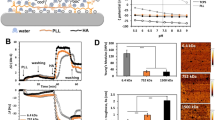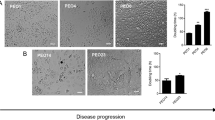Abstract
Ovarian cancer has the highest mortality rate of any gynaecological malignancy. This is caused by metastatic deposits obstructing the intestinal tract. Very little is known about the molecules involved in the initial attachment of the metastatic tumour cells to the peritoneal mesothelial lining. Previously, we showed that many ovarian tumour lines express the adhesion molecule, CD44, on their cell surface. The major ligand for CD44 is the extracellular matrix glycosaminoglycan, hyaluronic acid (HA). Because mesothelial cells have a pericellular cost that contains large amounts of HA, it was postulated that the CD44/HA interaction is an important stage in ovarian cancer spread. However, it was difficult to demonstrate this interaction in an in vitro adhesion assay with mesothelial cells as most of the HA, and presumably the bound tumour cells, were lost from the mesothelial cells during the washing steps of the assay. In order to try and clarify the situation, the adhesion of six ovarian tumour lines to immobilized HA was measured. Four lines expressed high levels of CD44 and two lines expressed negligible amounts. Preliminary experiments were carried out with one of the CD44-expressing lines. After coating a plate overnight with 3 mg ml−1 HA, the 5 min adhesion of this line varied between 2% and 73% according to the type of plate that was used. Falcon Micro Test III flexible plates gave the highest adhesion and was used for further experiments. Plates were coated with concentrations of HA between 0.001 mg ml−1 and 3 mg ml−1. All CD44 expressing lines adhered to HA, but the maximum adhesion and the adhesion strength varied with the line studied and was not closely related to the total CD44 expression. These results suggest that CD44 on ovarian tumour cells binds to HA on mesothelial cells. As much of the HA can be very easily lost from the mesothelial cell surface, additional factors such as the strength of the CD44/HA interaction, and the formation of bonds by the tumour cells with other membrane adhesion molecules, such as integrins, are also important in promoting tumour spread.
Similar content being viewed by others
References
Office of Population Census and Surveys (1994) Cancer Statistics 1989. HMSO.
Gardner MJ, Jones LMH, Catterall JB, Turner GA (1995) Cancer Lett 91: 229-34.
Catterall JB, Gardner MJ, Turner GA (1995) Cancer J 8: 320-4.
Jones LMH, Gardner MJ, Catterall JB, Turner GA (1995) Clin Exp Mets 13: 373-80.
Catterall JB, Gardner MJ, Jones MJ, Thompson GA, Turner GA (1994) Cancer Lett 87: 199-203.
Lesley J, Hyman R, Kincade PW (1993) Adv Immunol 151: 271-335.
Katoh S, Zheng Z, Oritani K, Shimozato T, Kincade PW (1995) J Exp Med 182: 419-29.
Lesley J, English N, Perschl A, Gregoroff J, Hyman R (1995) J Exp Med 182: 431-7.
Author information
Authors and Affiliations
Rights and permissions
About this article
Cite this article
Catterall, J.B., Gardner, M.J., Jones, L.M. et al. Binding of ovarian cancer cells to immobilized hyaluronic acid. Glycoconj J 14, 867–869 (1997). https://doi.org/10.1023/A:1018598223579
Issue Date:
DOI: https://doi.org/10.1023/A:1018598223579




